|
Mulch Comparisons:
|
I attempted to purchase as many as I could and use them on different beds throughout my garden. It was a mulch comparison contest in a search for the perfect material. I didn’t find it. There was, in my humble opinion, quite a wide range in usefulness and cost and they weren’t always correlated.
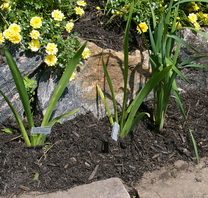
One of the things that I dislike about using mulch is, next year. Most of the common wood chip mulches contain a wide variety of particle sizes. I applied them to my beds last summer for the mulch comparisons and they all did a reasonable job of controlling the weeds and preserving moisture. That is their intended purpose. The second summer comes along and most of these wood chip mulches have changed. The fine particles have decomposed or integrated into the soil and I’m left with a sporadic covering of larger wood chips that may become useful organic matter some time in the next ten years.
The latest trend in soil maintenance is to use a minimum of tilling. Sell the rototiller. I haven’t sold mine but I do use it less. If you are working in beds where all of the plants are annuals and you start with bare soil each year then you have a choice of raking all of these wood chips off or working them into the soil. Both seem like bad choices to me. You can just leave them there and plant into the untilled soil and then add another layer of similar mulch. As the years pass you will develop a heavier coating of large wood chips which probably make a fine mulch but will be difficult to work with. I’m still doing mulch comparisons, looking for a mulch for my annual beds that looks better than shredded newspaper but still converts into a useful addition to the soil each year.
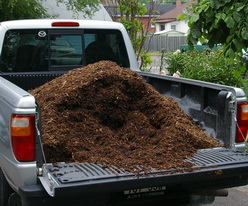 In perennial beds the problem is similar. If you want to add compost to that soil each year you wind up having to incorporate the big wood chips into the soil where they will take any number of years to decompose. If you are satisfied that the finer parts of the wood chip mulch are providing sufficient amendments for your soil then just buy more mulch and top it up.
In perennial beds the problem is similar. If you want to add compost to that soil each year you wind up having to incorporate the big wood chips into the soil where they will take any number of years to decompose. If you are satisfied that the finer parts of the wood chip mulch are providing sufficient amendments for your soil then just buy more mulch and top it up.
There was a significant spread in the costs of the various wood chips we used in the mulch comparisons. Cedar mulch always seems to be much less expensive. Maybe the world just has a bigger supply. If you have a trailer or small truck you can save considerable money by buying these items in bulk at some of the bigger garden supply outlets.
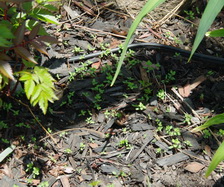
I found the cedar mulch, whose natural colour appeals to me, to be equally as effective as the more expensive types and had a similar amount of larger chips. It would appear, to me, that colour choice would be the only reason to buy the more expensive varieties. A reasonable crop of annual weeds showed up in all of them the next spring and in my mulch comparison gardens the black coloured one seemed to have the best crop of weed seedlings. None of them stop the surfacing of invasive perennial weeds.
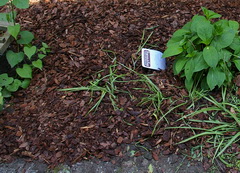 There is another group of products that we used in the mulch comparisons. They have consistent particle size and thus disappear from their intended location at a consistent rate. These all tend to be more expensive and they are rarely available in bulk. Pine bark nuggets, cocoa been shells and coconut husk chunks are the three that I have tried. Each has their own peculiarities and uses, at least for my gardening style. The Pine bark nuggets come in at least two sizes and are by far the most permanent. I use them in beds where little or no tilling or regular planting occurs. They can be easily pulled out of the way to insert another shrub but it would be a real pain to do that if you were planting a quantity of material.
There is another group of products that we used in the mulch comparisons. They have consistent particle size and thus disappear from their intended location at a consistent rate. These all tend to be more expensive and they are rarely available in bulk. Pine bark nuggets, cocoa been shells and coconut husk chunks are the three that I have tried. Each has their own peculiarities and uses, at least for my gardening style. The Pine bark nuggets come in at least two sizes and are by far the most permanent. I use them in beds where little or no tilling or regular planting occurs. They can be easily pulled out of the way to insert another shrub but it would be a real pain to do that if you were planting a quantity of material.
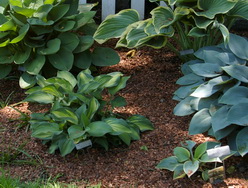
Cocoa bean shells have one great thing going for them. They smell like chocolate. They have a rich dark brown colour and a fine even texture. They are probably the most expensive, unless you happen to live near a chocolate factory and can get them in bulk. They can develop a white mould that is quite unsightly but it can be dealt with by cultivating the shells and letting them get quite dry. I use this product on a large bed near my patio because I like the colour and texture and enjoy the aroma. I would find it too expensive to use widely.
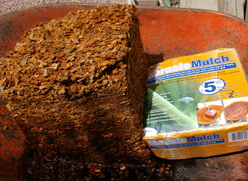 Relatively new to the market is the Coconut shell chunks. They also appear to be somewhat more expensive but mine survived the winter in such good shape that the ongoing cost of keeping this mulch on the same bed for several years will probably be very good. It is unique in its packaging. It comes in a small compressed bale that is very easy to transport. You dump the bale into wheelbarrow add considerable water and it swells up to many time its size. It doesn’t swell up nearly as quickly as the instructions would lead you to believe so I just developed a pattern of doing two jobs at the same time. By the time you had weeded and edged the next section of the bed the mulch was probably ready to be spread.
Relatively new to the market is the Coconut shell chunks. They also appear to be somewhat more expensive but mine survived the winter in such good shape that the ongoing cost of keeping this mulch on the same bed for several years will probably be very good. It is unique in its packaging. It comes in a small compressed bale that is very easy to transport. You dump the bale into wheelbarrow add considerable water and it swells up to many time its size. It doesn’t swell up nearly as quickly as the instructions would lead you to believe so I just developed a pattern of doing two jobs at the same time. By the time you had weeded and edged the next section of the bed the mulch was probably ready to be spread.
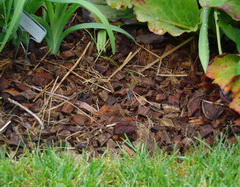
It has a rich golden colour that faded very little over the summer and was still quite acceptable the next spring. It is also easy to move to one side as you add or remove a few new perennials. My mulch comparisons have led me to continue to use this mulch on my perennial beds by topping them up with a bit of new material each year.
Now if I just lived near a Coconut plantation where I could fill my little truck.
You can search my entire site for answers to your other gardening mysteries.
